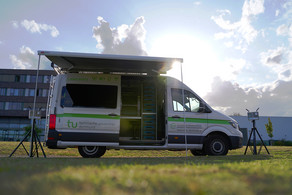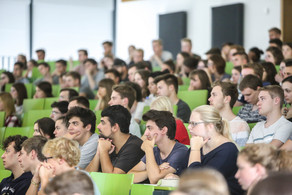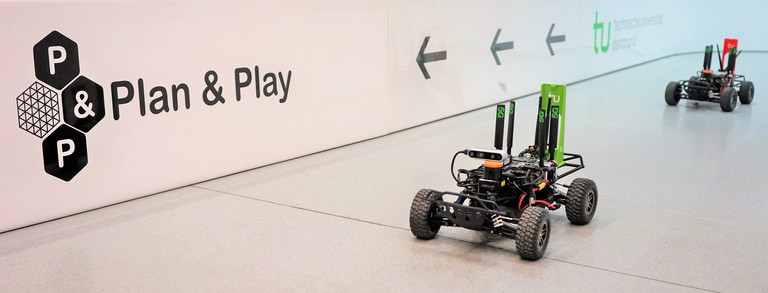Simulative Leistungsbewertung von Kommunikationsnetzen (SLK)
Termine
| Praktikum | Ort | Modul |
|---|---|---|
| Di, 20.02.2024 bis Do, 29.02.2024. Täglich von 09:00 Uhr bis 16:00 Uhr | Retina Pool C1-03-430 | ETIT-214 |
Die Veranstaltung findet gleichzeitig zum Praktikum Grundlagen der Simulation von Kommunikationsnetzen (GSK) statt.
Anmeldung
Bitte melden Sie sich im LSF zu dieser Veranstaltung an. Die Anmeldung ist bis zum 31.01.2023 23:59 Uhr möglich. Die Platzvergabe erfolgt anschließend nach §9 der Prüfungsordnung.
Zur Vergabe von Plätzen für Nachrücker wenden Sie sich bitte per E-Mail an die Betreuer (siehe unten).
Vorkenntnisse
Zur Teilnahme an dieser Veranstaltung sind Vorkenntnisse erforderlich, die mit den Inhalten des Moduls ETIT-108 Grundlagen der Simulation von Kommunikationsnetzen aus den Bachelorstudiengängen ETIT bzw. IKT vergleichbar sind.
Info
Das Praktikum 'Simulative Leistungsbewertung von Kommunikationssystemen' läuft nicht mehr parallel zu dem Praktikum der Vorlesung 'Modellbasierte Dimensionierung von Kommunikationssystemen' (MDK). Interessierte Studenten können sich daher sowohl für die Vorlesung MDK (ohne Praktikum) als auch für das Praktikum SLK eintragen. Eine Belegung beider Module, MDK und SLK ist daher möglich.
Lerninhalte
Das Praktikum greift behandelte theoretische Modelle und Analysemethoden der Vorlesung 'Modellbasierte Dimensionierung von Kommunikationssystemen' auf, welche ebenfalls im WS im Rahmen der Simulationsbildung und Modellierung angeboten wird. Besprochene theoretische Ansätze werden hierbei nachempfunden und praktisch angewendet. Bei diesem Praktikum handelt es sich um ein eigenständiges Modul, folglich ist eine Teilnahme an der Vorlesung MDK keine Voraussetzung, wird allerdings empfohlen um ein umfassendes Verständnis entwickeln zu können.
Folgende Themen werden in dem Praktikum behandelt:
- Erarbeiten der benötigten Grundlagen von OMNeT++
- Simulationsaufbau
- Modul- und Simulationsdefinition bzw. -deklaration
- Simulation einfacher Kommunikationsnetze
- Modellierung von Systemeigenschaften
- Modellierung von Kommunikationsprotokollen (ISO/OSI)
- Berücksichtigung von Mobilitätsaspekten on OMNeT++
- Modellierung und Berücksichtigung von Kommunikationskanaleigenschaften
- Umsetzung vollständiger Systemszenarien
- Bewertung und Optimierung von komplexen Kommunikationsystemen
- Simulation von dynamischen Kommunikationsnetzen
- Werkzeuge zur statistischen Analyse
- Validierung erhaltener Ergebnisse
Kompetenzen
Nach dem erfolgreichen Abschluss des Praktikums besitzen die Studierenden fundierte Kenntnisse über die Leistungsbewertung und Dimensionierung von Kommunikationssystemen mittels ereignis-gesteuerter Simulation. Dazu gehört neben den eigentlichen Funktionen der Simulationsumgebung OMNeT++ auch die Implementierung und hochgenaue simulative Umsetzung von protokollbasierten Abläufen in Kommunikationssystemen. Die Absolventen dieses Praktikums werden in der Lage sein, selbst komplexe Vernetzungsszenarien zu abstrahieren und realitätsgetreu in der Simulationsumgebung OMNeT++ abzubilden. Weiterhin können die so erhaltenen Ergebnisse entsprechend aufbereitet und zur Leistungsbewertung bzw. Optimierung, basierend auf nachrichtentechnisch relevanten Gesichtspunkten, genutzt werden.
Kreditpunkte
Um die 3 Kreditpunkte im Praktikum Simulative Leistungsbewertung von Kommunikationssystemen zu erreichen, werden nach Modulhandbuch für den Master Studiengang Elektrotechnik und Informationstechnik an der Technischen Universität Dortmund vom 30.01.2019 folgende Prüfungsleistungen gefordert:
- 80% der Praktikumsversuche sind erfolgreich zu bearbeiten.
- Für jeden Versuch ist ein Protokoll anzufertigen.
Literatur
- C. Wietfeld, Vorlesungsunterlagen Kommunikationsnetze
- D. Peterson, Computer Networks, 4th Edition
- JB. Sinclair, Simulation of Computer Systems and Computer Networks
- A. Vaga, OMNeT++ Manual 4.6, A. Vaga, https://omnetpp.org
- A. Vaga, OMNeT++ API Reference 4.6, https://omnetpp.org





